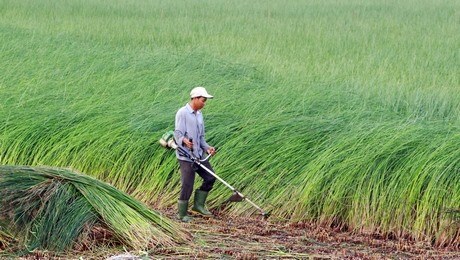Lác, a species of sedge used to make mats and other handicraft products, has a yield of 10-15 tons per hectare in the district, up a ton from previous crops.
Traders are buying it at VND 15,000 – 18,000 a kilogram, VND 1,500 – 2,000 higher than during the last crop.
Nguyen Kim Ba, who has 2,000sq.m of the sedge in Trung Thanh Dong commune, said there is more sunlight this time, creating better conditions for the plant.
As a result, the quality of lác is also high and traders are keen to buy them, he said.
    |
 |
|
Farmers in Vĩnh Long Province have brought in a good harvest of lác and are earning big profits. Photo: baovinhlong.com.vn |
He has earned a profit of VND 10 million (USD 440) this time, he said.
Nguyen Van Tam, a local trader, said the price of lác is high because supply cannot meet demand.
He buys one to two tons daily and sells to mat making villages in other provinces like Tien Giang and Dong Thap.
More than 1,000 households in Trung Thanh Dong commune have had good incomes after switching to grow lác on their infertile paddy fields.
Lác provides four to five harvests a year and is easy to grow.
The Mekong Delta province of Vinh Long has around 306 hectares under the crop, mostly in Trung Thanh Dong and Thanh Binh communes.
Trung Thanh Dong, the district’s largest lác planting area, has 227 hectares.
Besides providing stable incomes to farmers, the sedge also creates jobs for people who have to harvest, split, dry and spin the plant and weave mats, according to the district Agriculture and Rural Development Bureau.
Huynh Van Vu, Chairman of the Trung Thanh Dong Communal People’s Committee, told Thanh Nien (Young People) newspaper that farmers in the commune’s Dai Hoa, Dai Nghia and Phu Nong hamlets have converted all infertile paddies into lác fields.
“The profit from lác is six times that from rice.”
The commune has nearly 3,000 people, or 70 percent of its workforce, whose jobs are related to the crop.
Laborers earn VND 60,000 -70,000 (USD 2.6 - 3) a day from harvesting, splitting, drying, and spinning it.
The district will encourage farmers to grow lác in zoned areas and saltwater-contaminated areas, according to the bureau.
Authorities would continue to identify buyer companies to guarantee outlets for products made from lác, it added.
Source: VNA